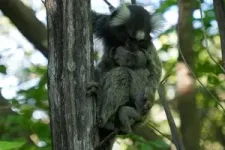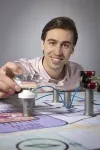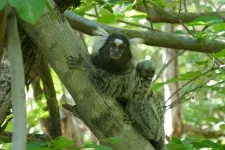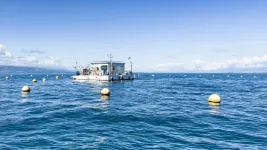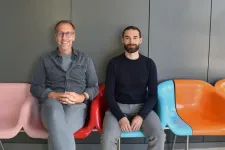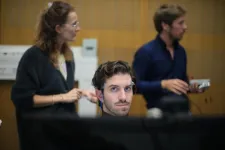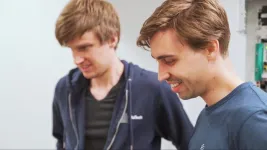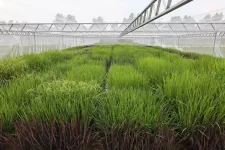(Press-News.org)
Someday, people might finally say goodbye to defrosting the freezer or scraping frost off slippery surfaces. Northwestern University engineers have developed a new strategy that prevents frost formation before it begins.
In a new study, the researchers discovered that tweaking the texture of any surface and adding a thin layer of graphene oxide prevents 100% of frost from forming on surfaces for one week or potentially even longer. This is 1,000 times longer than current, state-of-the-art anti-frosting surfaces.
As an added bonus, the new scalable surface design also is resistant to cracks, scratches and contamination.
By incorporating the textured surface into infrastructure, the researchers imagine companies and government agencies could save billions of dollars per year in averted maintenance costs and energy inefficiencies.
The research will be published on Wednesday (Oct. 30) in the journal Science Advances.
“Unwanted frost accumulation is a major concern across industrial, residential and government sectors,” said Northwestern’s Kyoo-Chul Kenneth Park, who led the study. “For example, the 2021 power crisis in Texas cost $195 billion in damages, resulting directly from frost, ice and extreme cold conditions for more than 160 hours. Thus, it is critical to develop anti-frosting techniques, which are robust for long periods of time in extreme environmental conditions. It is also necessary to develop anti-frosting methods which are easy to fabricate and implement. We designed our hybrid anti-frosting technique with all of these needs in mind. It can prevent frosting for potentially weeks at a time and is scalable, durable and easily fabricated through 3D printing.”
Park is an assistant professor of mechanical engineering at Northwestern’s McCormick School of Engineeringand a faculty affiliate of the Paula M. Trienens Institute for Sustainability and Energy and the International Institute for Nanotechnology.
Leaf-inspired discovery
The new study builds upon previous work from Park’s laboratory. In 2020, Park and his team discovered that adding millimeter-scale textures to a surface theoretically reduced frost formation by up to 80%. Published in the Proceedings of the National Academy of Sciences, the research was inspired by the rippling geometry of leaves.
“There is more frost formation on the convex regions of a leaf,” Park said at the time. “On the concave regions (the veins), we see much less frost. People have noticed this for several thousands of years. Remarkably, there was no explanation for how these patterns form. We found that it’s the geometry — not the material — that controls this.”
Through experimental work and computation simulations, Park and his collaborators found that condensation is enhanced on the peaks and suppressed in the valleys of wavy surfaces. The small amount of condensed water in the valleys then evaporates, resulting in a frost-free area.
Graphene-oxide trapping power
In the previous study, Park’s team developed a surface featuring millimeter-scale peaks and valleys with small angles in between. In the new study, Park’s team added graphene oxide on flat valleys, which reduced frost formation by 100% in those valleys. The new surface comprises tiny bumps, with a peak-to-peak distance of 5 millimeters. Then a thin layer of graphene oxide, just 600 microns thick, coats the valleys between peaks.
“Graphene oxide attracts water vapor and then confines water molecules within its structure,” Park said. “So, the graphene oxide layer acts like a container to prevent water vapor from freezing. When we combined graphene oxide with the macrotexture surface, it resisted frost for long times at high supersaturation. The hybrid surface becomes a stable, long-lasting, frost-free zone.”
When compared to other state-of-the-art anti-frosting surfaces, Park’s method was the clear winner. While superhydrophobic (water repelling) and lubricant-infused surfaces resisted 5-36% of frost formation for up to 5 hours, Park’s surface resisted 100% of frost formation for 160 hours.
“Most other anti-frosting surfaces are susceptible to damage from scratches or contamination, which degrades surface performance over time,” Park said. “But our anti-frosting mechanism demonstrates robustness to scratches, cracks and contaminants, extending the life of the surface.”
Why it matters
This hybrid macrotexture-graphene oxide surface offers a promising solution for preventing frost formation in various applications. Most people only worry about frost when it coats their car windshield or kills their outdoor plants. But frost is more than a nuisance.
Frost on airplane wings can create drag, making flights dangerous or even impossible. When accumulating inside freezers and refrigerators, frost greatly reduces energy efficiency in appliances. Frost can add too much weight to power lines, leading to breakage and, ultimately, power outages. It also can impair sensors on vehicles, harming their ability to accurately detect objects.
“Developing new anti-frosting techniques is crucial to preventing costly mechanical failures, energy inefficiencies and safety hazards for critical operations,” Park said. “There currently is no ‘one-size-fits-all’ approach because every application has specific needs. Although airplanes only require seconds of frost resistance, powerlines operating in cold environments might require days or weeks of frost resistance, for example. With our new insights, we could design powerlines and airplane wings with reduced ice adhesion. These types of alterations would greatly reduce yearly maintenance costs.”
The study, “Robust hybrid diffusion control for long-term scalable frost prevention,” was partially supported by the National Science Foundation (grant number CBET-2337118) and the Korea Institute for Science and Technology (grant number 2E32527).
END
The development of primate brains is shaped by various inputs. However, these inputs differ between independent breeders, such as great apes, and cooperative breeders, such as the common marmoset (Callithrix jacchus) and humans. In these species, group members other than the parents contribute substantially to raising the infants from birth onwards.
A group of international researchers led by Paola Cerrito from the University of Zurich’s Department of Evolutionary Anthropology studied how such social interactions map onto brain development in common marmosets. The study provides new insights into the relationship between the timing of brain development ...
LEUVEN October 31st - Alzheimer’s disease is characterized by a progressive loss of nerve cells leading to a decline in memory and cognition. A team of researchers at KU Leuven and VIB explored the molecular sequence of events in this cellular demise and identified specific inhibitors that could prevent the loss of nerve cells in different mouse models of the disease. The findings open up new research avenues in the search for therapies that could halt or prevent the accumulation of brain damage occurring in ...
Unlike oceans, lakes are significant emitters of CO₂. But why is this the case, and what mechanisms are at play? For the first time, UNIL scientists have successfully explained the complete carbon cycle in Lake Geneva, creating a model that can be applied to several of the world's largest lakes.
Contrary to previous beliefs, it is the natural erosion of rocks that is responsible for the significant CO2 emissions from Lake Geneva and many of the world's large lakes.
This study provides the missing piece for understanding the carbon cycle in lakes.
The LéXPLORE lake platform in Switzerland played a major role in this discovery of international ...
Unseen and ongoing, thousands of times every second: to keep a complex organism like humans alive, an immense number of new cells must be continuously produced. Up close, each of these cell divisions is nothing short of a miracle. Within just a few hours, not only must the entire genome – billions of “letters” long – be replicated, but most other cellular structures must be doubled so that, in the end, two complete daughter cells can emerge.
Just before division, two complex protein structures, known as centrosomes, emerge, forming two opposing poles in the mother cell. These centrosomes grow long protein filaments, the spindle apparatus, ...
As we age, it becomes more difficult to remember where things are—whether it’s recalling where we left the keys or where we parked the car. This spatial memory deteriorates further with the onset of dementia, a condition that someone in the world develops every three seconds, according to Alzheimer’s Disease International.
Researchers at two EPFL labs have joined forces to give a boost to spatial memory by creating a unique experimental setup that combines non-invasive deep-brain stimulation, virtual reality training, and fMRI imaging—all housed within Campus Biotech in Geneva. Published in Science Advances, the study demonstrates that targeted, ...
An international research team led by QuTech has demonstrated a network connection between quantum processors over metropolitan distances. Their result marks a key advance from early research networks in the lab towards a future quantum internet. The team developed fully independently operating nodes and integrated these with deployed optical internet fibre, enabling a 25 km quantum link. The researchers published their findings in Science Advances.
The internet allows people to share information (bits) globally. A future quantum internet will enable sharing quantum information (qubits) over a new type of network. Such qubits ...
Black patients are less likely than white patients to receive medical tests that doctors use to diagnose severe disease, such as sepsis, researchers at the University of Michigan have shown.
Because of the bias, some sick Black patients are assumed to be healthy in data used to train AI, and the resulting models likely underestimate illness in Black patients. But that doesn't mean the data is unusable—the same group developed a way to correct for this bias in data sets used to train AI.
These new insights are reported in a pair of studies: one published ...
HOUSTON ― The University of Texas MD Anderson Cancer Center’s Research Highlights showcases the latest breakthroughs in cancer care, research and prevention. These advances are made possible through seamless collaboration between MD Anderson’s world-leading clinicians and scientists, bringing discoveries from the lab to the clinic and back.
Epigenetic targets and genomic stem cell pathways drive adult hair regeneration
Retrotransposons are interspersed repeating sequences that make up over 40% of the human genome. Proper tissue regeneration requires ...
Toronto, ON, October 30, 2024 – Three Baycrest leaders are among those named winners of Women Executive Network’s (WXN) prestigious 2024 Canada’s Most Powerful Women: Top 100 Awards, celebrating exceptional leadership and groundbreaking achievements that have meaningfully transformed their industries, companies, communities and country.
Dr. Allison Sekuler, President and Chief Scientist, Baycrest Academy for Research and Education and President and Chief Scientist, Centre for Aging + Brain Health Innovation, powered by Baycrest (CABHI)
Dr. ...
Cold damage is a major challenge in rice production, and identifying key gene modules in signaling pathways is a crucial means of addressing this issue. A Chinese research team has recently discovered a part of the plant’s cell membrane that helps plants sense when it's cold.
This cell membrane component, known as the COLD6-OSM1 module, triggers the production of a special molecule, 2',3'-cAMP, which helps plants sense and respond to low temperatures. This secondary messenger is a key upstream component that mediates the signaling pathway by directly responding to signals ...

